Overview
The title "10 Essential Turnaround Leadership Solutions for Business Recovery" raises a pivotal question: what key strategies can leaders adopt to drive recovery in struggling businesses? This article delineates several turnaround leadership solutions, including:
- Financial assessments
- Operational restructuring
- Effective communication
These elements are vital for restoring stability and fostering sustainable growth in organizations grappling with financial challenges. By implementing these strategies, leaders can not only navigate their businesses through turbulent times but also position them for future success.
Introduction
In the face of economic uncertainty, small and medium businesses often find themselves at a crossroads, grappling with financial challenges that threaten their very existence. Comprehensive turnaround consulting services emerge as a beacon of hope, offering a strategic lifeline to those in need.
By focusing on:
- Financial assessments
- Operational restructuring
- Effective management practices
These services empower organizations to not only recover but thrive in a competitive landscape. Moreover, as businesses navigate the complexities of recovery, insights drawn from successful case studies and expert methodologies illuminate the path toward sustainable growth.
With an increasing number of organizations recognizing the value of strategic consulting, the time has never been more critical to explore how these services can transform potential crises into opportunities for success.
Transform Your Small/ Medium Business: Comprehensive Turnaround Consulting Services
are essential for small and medium enterprises that are facing financial challenges. These services encompass financial assessments, operational restructuring, interim management, and , all designed to facilitate recovery and growth. By pinpointing opportunities for cash preservation and liability reduction, consultants empower SMEs to regain stability and lay the groundwork for sustainable success. Our in-depth financial assessments focus on cash preservation, operational efficiency, and risk mitigation, revealing inefficiencies and potential cost-saving strategies that enable organizations to optimize operations and enhance profitability.
Current trends indicate that 65.3% of small enterprises are profitable, with 80% of owners expressing optimism about their future. This positive outlook underscores the effectiveness of recovery consulting, particularly in 2025, where comprehensive financial assessments have proven to significantly influence recovery rates. Successful case studies demonstrate how SMEs have transformed their operations through extensive consulting and the implementation of turnaround leadership solutions, resulting in improved financial health and operational efficiency. As one satisfied client noted, 'Within 100 days of meeting the SMB team, my company was in a better position financially and strategically than it had been in years,' highlighting the transformative experience with the SMB team via the 'Rapid30' plan. Furthermore, the competitive landscape of consulting services accentuates the necessity for high-quality service delivery. As the demand for consulting services focused on transformation continues to rise, companies that leverage these expert insights are better positioned to thrive in a competitive environment.
BCG: Expert Turnaround and Restructuring Consulting
Boston Consulting Group (BCG) is recognized for its exceptional capabilities in providing turnaround leadership solutions and restructuring consulting. Their methodology initiates with an in-depth analysis of a client's financial health and operational efficiency, establishing a solid foundation for recovery. A key emphasis is placed on mastering the cash conversion cycle, utilizing 20 specific approaches that enhance organizational performance and streamline decision-making processes.
The special situations group collaborates closely with enterprises to develop tailored plans that not only address urgent financial challenges but also incorporate turnaround leadership solutions for sustainable growth. Key methodologies employed by BCG, such as scenario planning and risk assessment, serve as essential tools for navigating volatile market conditions.
Notably, companies that significantly invest in restructuring initiatives often witness a long-term total shareholder return (TSR) exceeding industry averages by 5.7 percentage points, underscoring the value of strategic financial health analysis. Furthermore, digital leaders experience nearly double the earnings growth compared to digital laggards, highlighting the critical importance of adopting in a digital context.
BCG's commitment to continuous performance monitoring through real-time analytics enables the application of lessons learned, fostering strong, lasting relationships with clients. Success stories from 2025 illustrate how turnaround leadership solutions are effective in driving transformational change, establishing them as a trusted partner for organizations aiming to enhance their financial stability and operational resilience.
As emphasized by an executive, the adoption of agile DevOps by IT teams has facilitated close operational ownership, rapid iterations, and continuous feedback, showcasing a practical example of how BCG's methodologies can lead to operational efficiency. This aligns with the broader industry values that consultants, like BCG, strive to bring to clients and society.
Art Petty: Nine Rules for Effective Turnaround Leadership
Art Petty outlines nine essential rules for effective turnaround leadership solutions, which are crucial for navigating business restoration. These rules emphasize the importance of:
- Addressing root causes rather than simply treating symptoms
- Fostering open communication
- Prioritizing team development
A proactive leadership style is imperative, as it promotes collaboration and innovation within the organization. For instance, leaders should emphasize transparency to build trust, ensuring that all team members are aligned with recovery goals. This strategy not only enhances communication but also significantly influences the success rates of turnaround leadership solutions.
Notably, organizations that utilize real-time analytics through a client dashboard to monitor business health can make swift, informed decisions, preserving capital and optimizing performance. Communication tools demand considerable time, with text-based chat accounting for 3.89 hours and file-sharing documents for 3.33 hours of communication time weekly.
Organizations that implement turnaround leadership solutions, often referred to as ',' have demonstrated a remarkable 264% greater revenue growth and are 50% more likely to secure long-term growth opportunities. By adhering to Petty's principles and applying lessons learned during the recovery process, individuals can foster a resilient organizational culture, better equipped to confront challenges and promote sustainable success.
Furthermore, it is crucial to recognize that 60% of women in leadership roles report facing greater scrutiny than their male counterparts, underscoring the importance of inclusive leadership during transitions. By integrating these insights and committing to building strong connections, individuals can enhance their effectiveness and adeptly navigate the complexities of recovery.
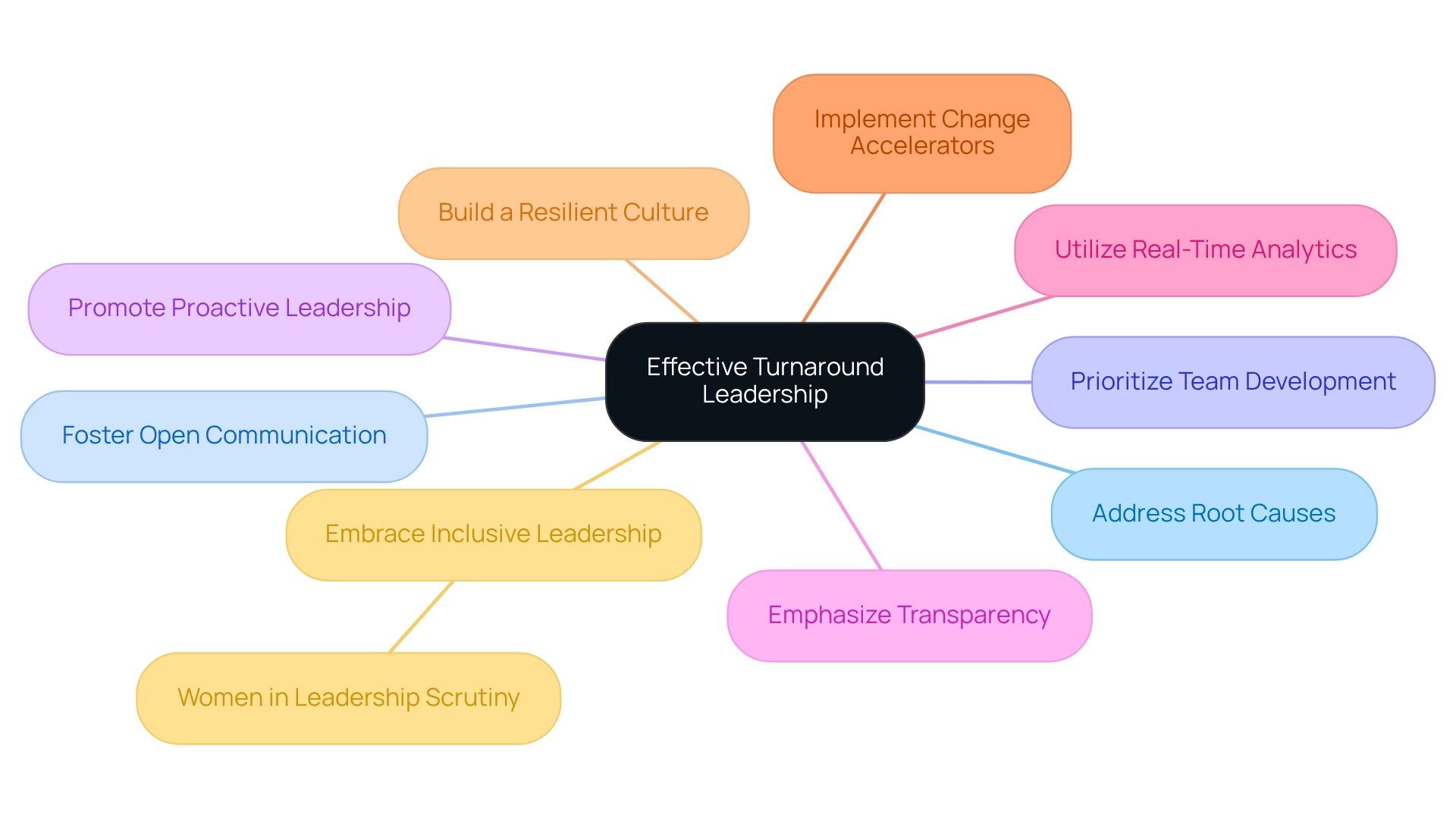
Cowen Partners: Hiring Visionary Leaders for Business Turnarounds
Recruiting innovative leaders is essential for effective organizational transformations. Leaders equipped with strategic foresight not only inspire and motivate teams but also demonstrate the agility to identify opportunities for innovation and growth, particularly in challenging circumstances.
For instance, adept leaders can pivot business strategies to align with evolving market demands, ensuring that the organization remains competitive. Emphasizing qualities such as adaptability and emotional intelligence significantly enhances the effectiveness of turnaround leadership solutions. Current trends reveal that organizations must prioritize these attributes when selecting leaders, as 45% of CEOs express concern regarding their company's future.
Moreover, with women occupying only 17% of board seats, recognizing the value of diverse perspectives in leadership is crucial. By fostering that values visionary thinking and inclusivity, organizations can establish robust support systems that enhance leadership effectiveness and promote turnaround leadership solutions for sustainable recovery.
The SMB team's commitment to implementing insights from their 'Rapid30' plan exemplifies how effective recovery strategies can transform enterprises. Their approach encompasses hypothesis testing, quick decision-making, and real-time analytics, which are vital for monitoring performance and ensuring client satisfaction.
As Benjamin Franklin wisely stated, failing to prepare is preparing to fail, underscoring the necessity of proactive leadership during crises. Acknowledging the challenges leaders encounter, including the anxiety surrounding company survival, enables organizations to better support their leaders, ultimately enhancing leadership effectiveness.
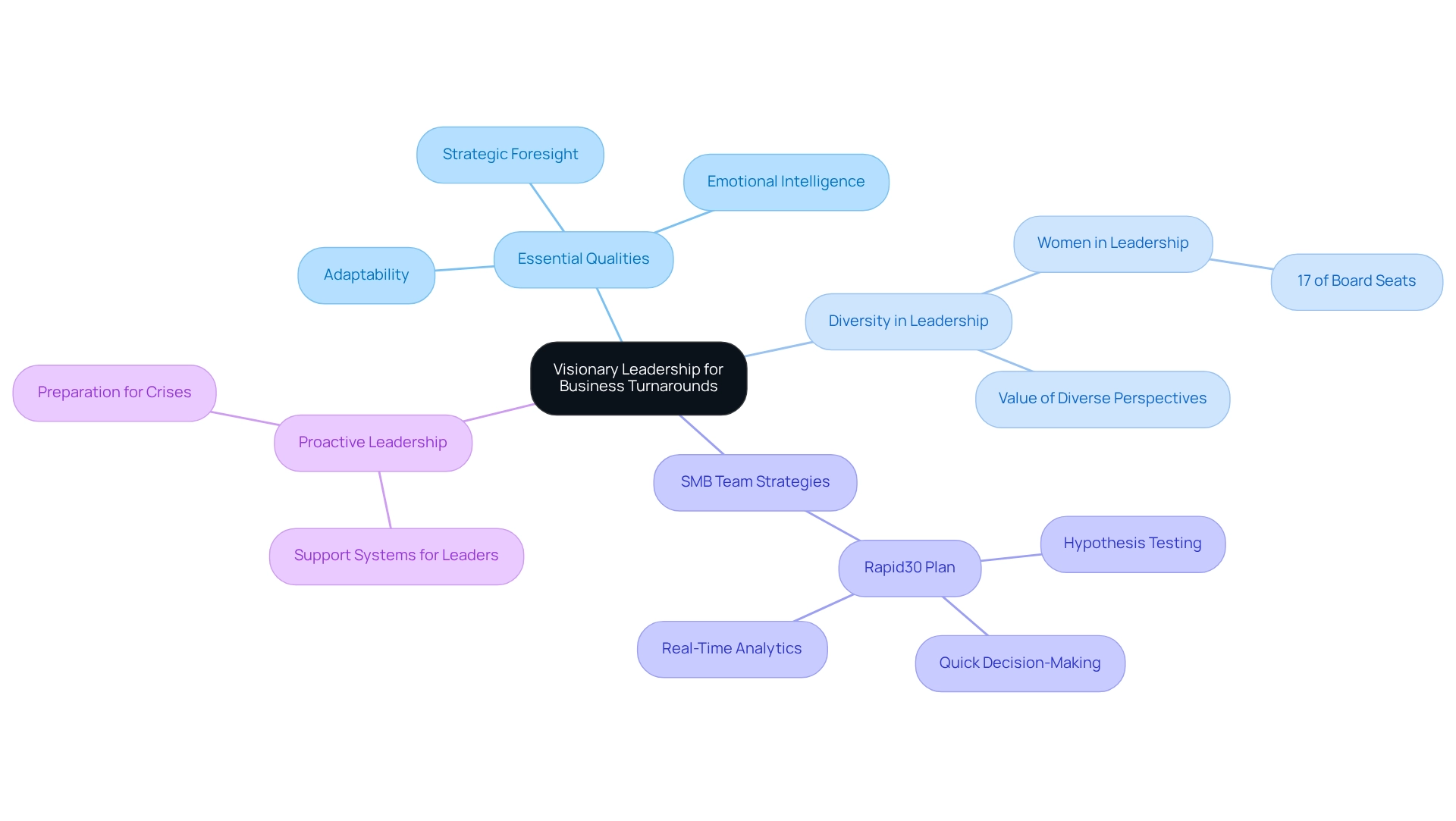
Scott Dylan: Leadership Strategies for Successful Business Turnarounds
Scott Dylan advocates for a people-focused leadership style during business transformations, emphasizing the essential importance of clear communication and team involvement. His approaches promote cultivating a culture of accountability, where prioritizing employee needs and concerns creates an environment ripe for transformation.
Involving team members in decision-making processes not only improves buy-in but also reinforces dedication to the recovery plan. Moreover, the implementation of real-time analytics through client dashboards allows for continuous monitoring of business health, enabling quick adjustments to strategies as needed. Additionally, testing hypotheses is essential to ensure that decisions are data-driven and effective.
Research indicates that effective managerial support significantly influences company culture, with 71% of employees considering a job change for , as highlighted in the case study titled "Importance of Managerial Support and Flexibility." This underscores the necessity of work-life balance in recovery efforts.
As Jim Harter, Ph.D., Chief Scientist at Gallup, notes, "Workplace effectiveness is deeply tied to how well employees feel supported and engaged." Dylan's focus on empathy and teamwork serves as a strong reminder that successful transformations require turnaround leadership solutions as much as they depend on the individuals engaged and the procedures put in place.
By fostering a supportive environment and implementing lessons learned from the recovery process, leaders can drive meaningful change and achieve sustainable growth. Furthermore, using tools such as Pumble can improve collaboration and lessen dependence on email, further enhancing team involvement during crucial phases.
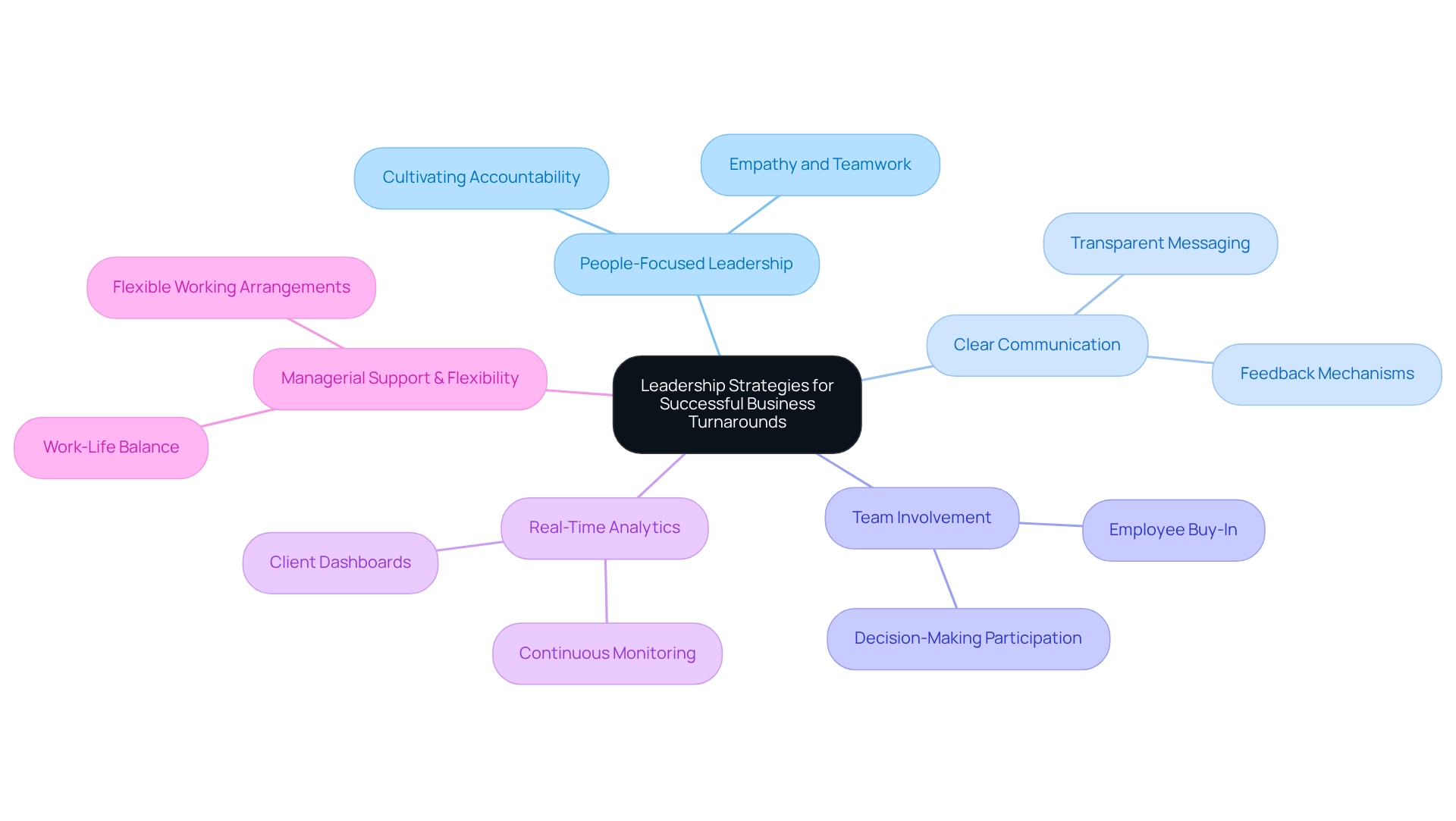
Echo Maintenance: Enhancing Operational Efficiency in Turnarounds
Improving operational efficiency is essential for companies that are implementing while navigating transformations. Organizations excel in deploying strategies that streamline processes and minimize costs. Techniques such as process mapping and performance metrics are instrumental in pinpointing bottlenecks and identifying areas ripe for improvement.
For instance, the adoption of lean management principles can yield substantial waste reductions and significantly boost productivity. Research indicates that there can be as much as a 100% difference in marginal productivity between transformations at facilities of differing sizes, underscoring the importance of customized strategies for operational efficiency.
As John Roup, a Project Manager specializing in change management consulting, states, 'Fortunately, there is a better method.' By prioritizing operational efficiency, organizations not only stabilize their current circumstances but also lay the groundwork for sustainable growth.
Moreover, case studies like ING’s Agile Operating Model demonstrate how restructuring efforts can enhance adaptability and significantly reduce time-to-market for new offerings, ultimately leading to improved financial performance. In addition, our team facilitates a condensed decision-making cycle during the turnaround leadership solutions process, which enables organizations to take assertive measures to maintain their operations.
Ongoing tracking via real-time analytics allows organizations to evaluate their performance and modify approaches as needed, implementing lessons learned to cultivate strong, enduring relationships. As businesses implement these strategies, they position themselves to thrive in an increasingly competitive landscape.
Jacobs Advisory Group: Key Leadership Traits for Turnaround Success
The Jacobs Advisory Group underscores several essential leadership traits that are vital for achieving turnaround success. emerges as a cornerstone, empowering individuals to navigate setbacks while maintaining a focus on long-term objectives. In 2025, the significance of resilience is underscored by findings that 12.5% of organizations felt unprepared for crises such as COVID-19, highlighting the necessity for individuals who can adapt and persevere. Cultivating resilience through training and preparation yields both short-term and long-term advantages for organizations, reinforcing the importance for leaders to be well-prepared.
Decisiveness is equally crucial; prompt actions taken by those in charge can significantly alleviate challenges and steer organizations back on track. This aligns with the need for a shortened decision-making cycle, enabling teams to take decisive action to preserve business health. Furthermore, effective communication fosters transparency and trust, essential for uniting teams around a shared vision. As Seville observed, "The educational authorities should be ready to react in times of crises so that these challenging situations do not deplete their resilience." By fostering these qualities, organizations can enhance their leadership effectiveness, ultimately improving their chances for a successful recovery.
Ongoing observation of business performance via real-time analytics is essential, as it enables executives to assess business well-being and adjust strategies accordingly. Notably, the revival of Apple under Steve Jobs exemplifies how decisive leadership and a resilient mindset can transform a struggling company into a market champion, emphasizing the importance of these qualities in recovery situations. For CFOs, understanding and nurturing these leadership traits is crucial, as they directly influence financial decision-making and organizational stability during challenging times. Additionally, operationalizing lessons learned from past experiences can further enhance leadership effectiveness, providing actionable insights applicable in real-world scenarios.
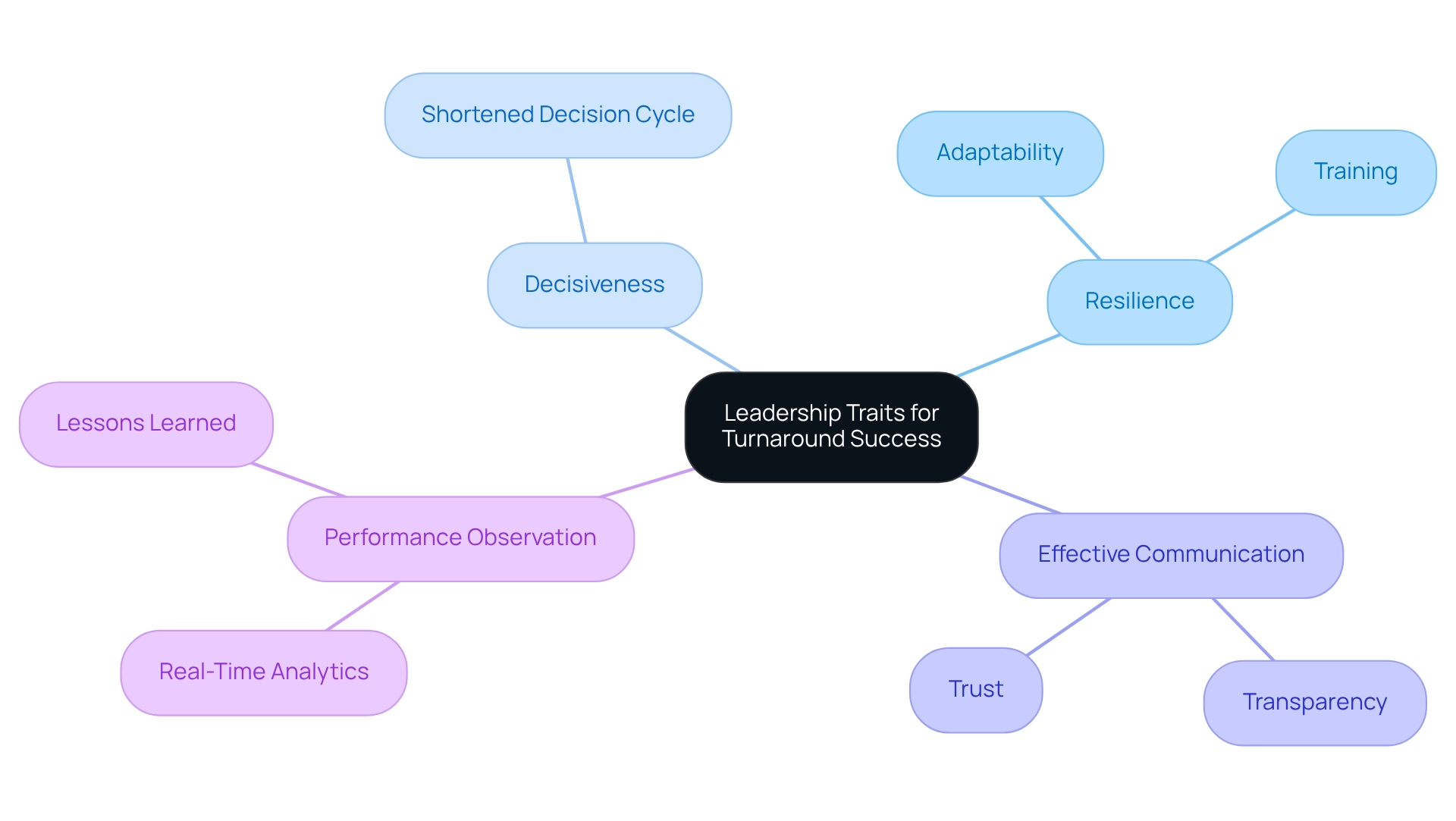
LinkedIn Insights: Modern Strategies for Turnaround Leadership
Contemporary turnaround leadership solutions emphasize agility, data-informed decision-making, and the development of an innovative culture. Insights from industry experts highlight the importance of utilizing technology to enhance communication and collaboration among teams. For instance, the adoption of project management tools significantly streamlines workflows and enhances accountability.
Moreover, individuals in authority are urged to establish feedback mechanisms that promote ongoing enhancement and the adjustment of plans in real-time. By employing a pragmatic approach to data, organizations can test hypotheses to deliver maximum returns on invested capital, ensuring that decisions are informed and effective.
Notably, data-driven strategies are projected to outperform gut feelings in 65% of B2B sales organizations by 2026, highlighting the critical role of data in effective decision-making. As Diamond Okeke, an experienced writer, observes, grasping the changing environment of finance and marketing is crucial for leaders today.
Furthermore, the dedication to ongoing performance evaluation through real-time analytics enables organizations to assess their well-being effectively and implement insights gained from recovery processes. The case study of Shopify demonstrates can drive business growth and improve decision-making processes, resulting in increased sales and customer acquisition.
By adopting these modern strategies, executives can skillfully manage the challenges present in recovery scenarios through turnaround leadership solutions, ensuring a more adaptable and responsive organizational structure.
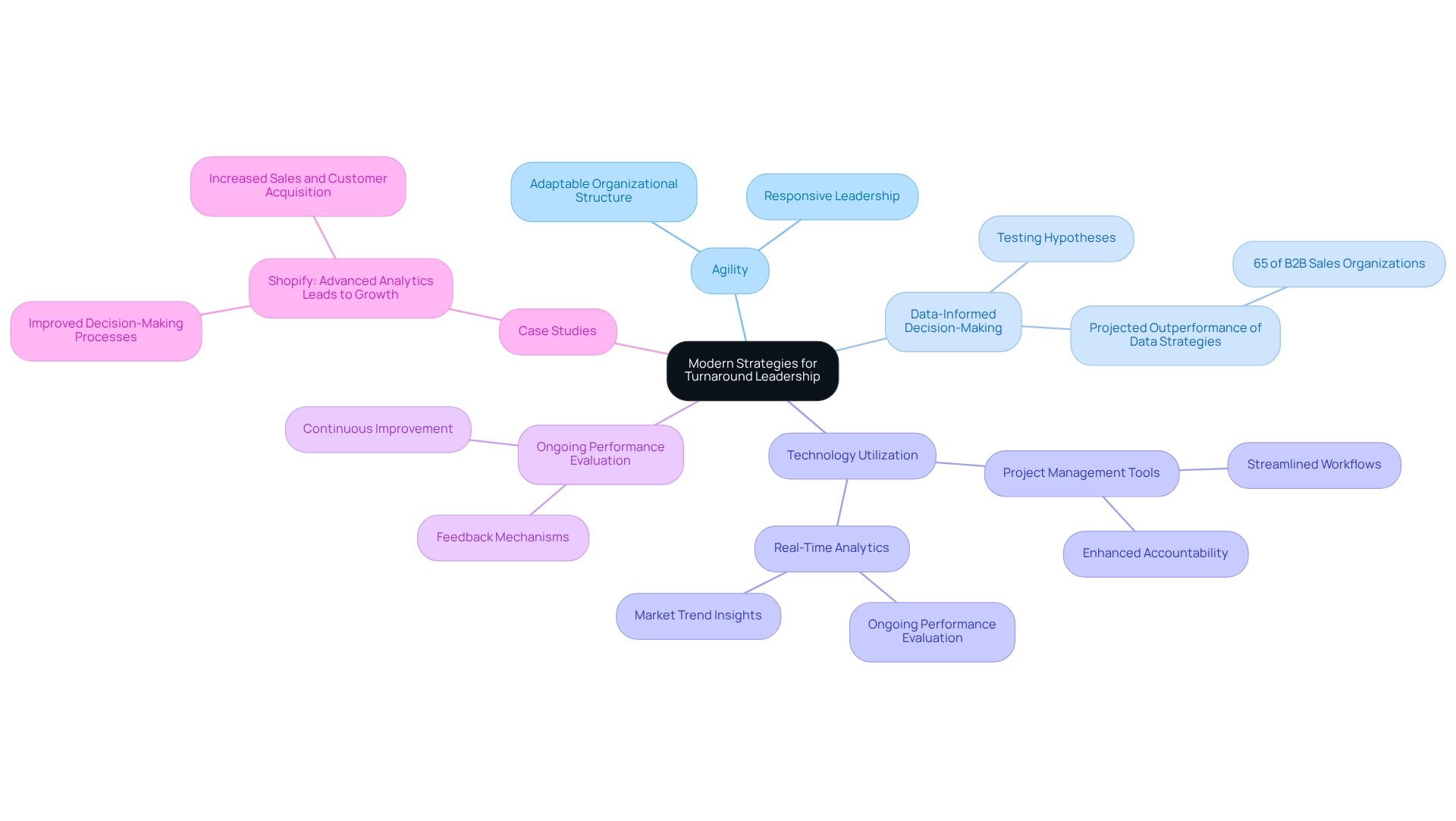
HPB: Practical Tools for Turnaround Leadership
HPB presents a compelling collection of instruments tailored to empower executives in their recovery efforts with turnaround leadership solutions. Notably, performance dashboards provide real-time insights into critical metrics, enabling leaders to make swift, informed decisions. Our team champions a condensed decision-making cycle throughout the recovery process, facilitating prompt actions that sustain business health.
Furthermore, the integration of risk assessment frameworks is essential, as they identify potential challenges and develop effective mitigation strategies. Communication templates also play a crucial role in crafting to stakeholders, ensuring alignment with turnaround leadership solutions. As Christopher Pappas emphasizes, "In leadership, clarity of purpose is key," highlighting the significance of these templates in maintaining focus during challenging times.
By leveraging these tools, leaders can significantly enhance their effectiveness with turnaround leadership solutions, fostering a culture of data-driven decision-making that is vital for successful outcomes. Organizations that adopt performance dashboards report a remarkable 69% increase in employee engagement, as team members feel more valued and involved in the recovery process.
Moreover, our commitment to ongoing performance monitoring through real-time analytics enhances collaborative decision-making and integrates data review practices into operational workflows. This holistic approach not only streamlines operations but also nurtures an environment conducive to sustainable growth. Additionally, we are dedicated to implementing the lessons learned throughout the transformation process, ensuring that insights gained are effectively woven into future strategies.
HPB also provides comprehensive documentation and APIs for clients, further demonstrating our commitment to empowering enterprises effectively.
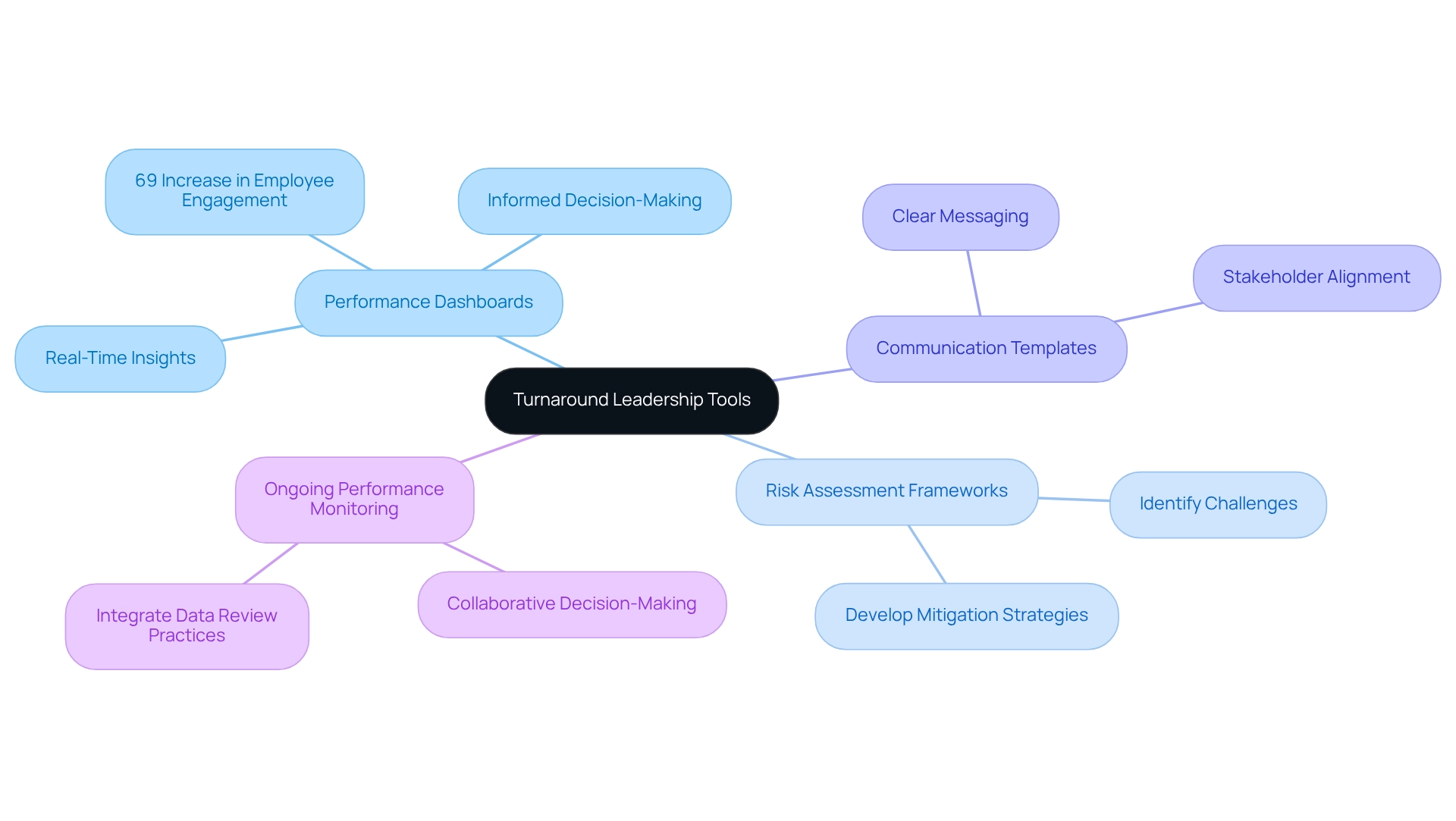
Innovative Technology Solutions for Business Turnaround
For successful organizational turnarounds, innovative technology solutions are crucial as part of turnaround leadership solutions. Technologies such as artificial intelligence (AI), data analytics, and cloud computing significantly enhance operational efficiency and decision-making processes. A report by Algorithmia indicates that 57% of companies utilizing AI/ML have adopted the technology to improve customer experience, underscoring its impact on operational efficiency.
AI-driven analytics offer profound insights into customer behavior, enabling companies to tailor their offerings and boost sales. Furthermore, a study by MIT Sloan Management reveals that 87% of global organizations believe AI technologies will provide them with a competitive edge, presenting a compelling case for CFOs to assess these technologies in their recovery strategies.
Continuous organizational performance monitoring through real-time analytics allows entities to effectively diagnose their health and adjust strategies promptly. The case study of Baublebar, an e-commerce jewelry retailer, exemplifies how big data analytics aligns product offerings with fashion trends, showcasing the practical application of innovative technology in achieving .
Additionally, cloud-based solutions facilitate seamless collaboration and data sharing, empowering teams to operate efficiently across various locations. By embracing these technologies, organizations can streamline operations, enhance responsiveness, and strategically position themselves for turnaround leadership solutions, ensuring sustainable growth and resilience in an ever-evolving market landscape.
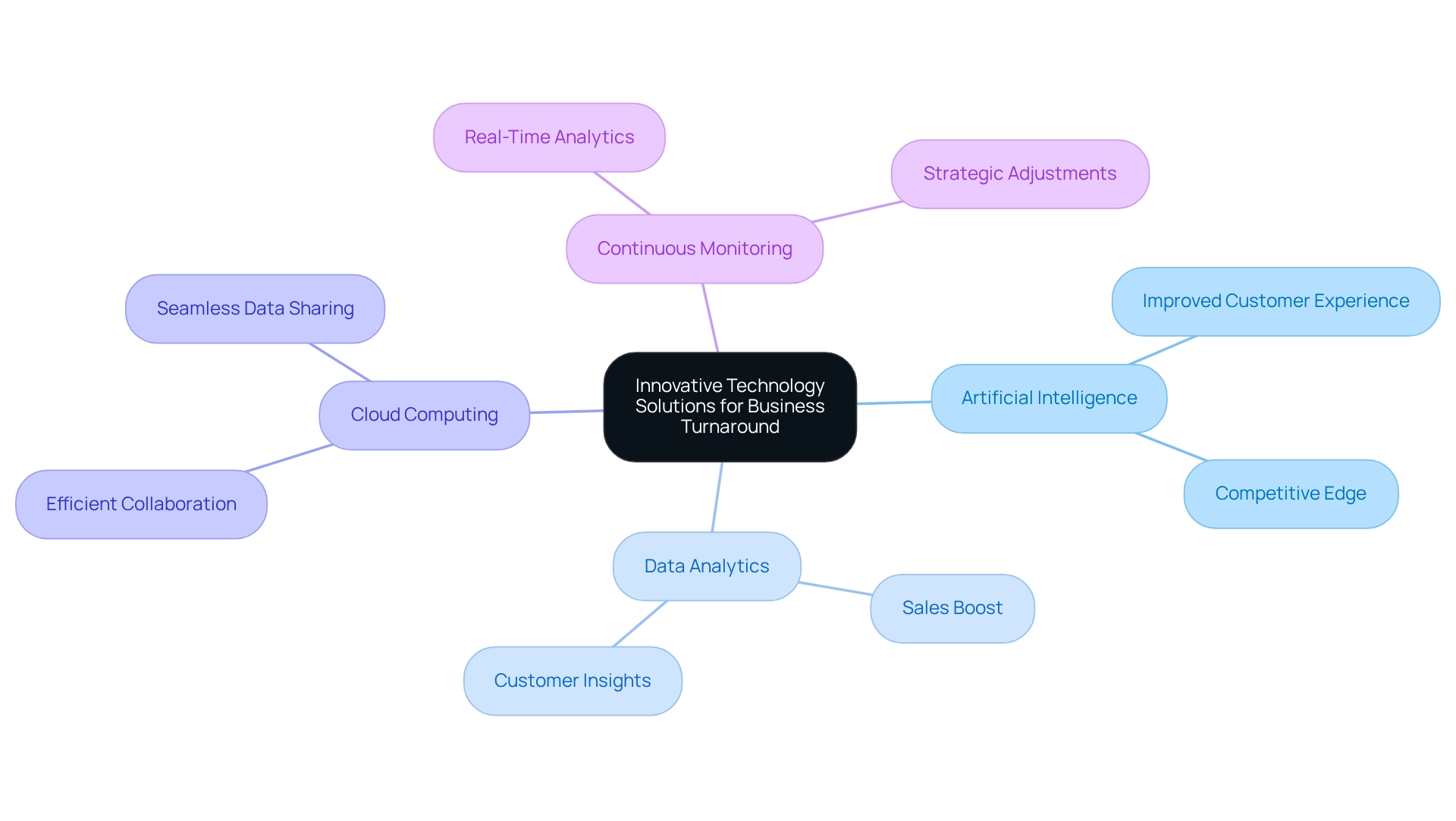
Conclusion
Comprehensive turnaround consulting services are essential for small and medium businesses confronted with financial challenges, enabling them to emerge stronger. By concentrating on financial assessments, operational restructuring, and effective management practices, these services offer the strategic guidance necessary for recovery and sustainable growth. The positive statistics surrounding small business profitability and owner optimism underscore the effectiveness of these consulting efforts, particularly when informed by successful case studies and expert methodologies.
Insights from industry leaders highlight the significance of adaptability, data-driven decision-making, and innovative leadership in cultivating a culture of resilience. Embracing modern technologies and implementing practical tools can markedly enhance organizational efficiency and communication, ensuring businesses can pivot effectively in response to market demands. Furthermore, the focus on inclusive leadership and the development of strong relationships within teams reinforces the idea that successful turnarounds depend not only on processes but also on people.
In conclusion, as the business landscape continues to evolve, organizations must recognize the value of strategic consulting to transform potential crises into opportunities for lasting success. By operationalizing lessons learned and committing to continuous improvement, businesses can position themselves to thrive amidst challenges, driving both financial stability and operational excellence in an increasingly competitive environment.
Frequently Asked Questions
What are comprehensive turnaround leadership solutions?
Comprehensive turnaround leadership solutions are services designed to assist small and medium enterprises (SMEs) facing financial challenges. They include financial assessments, operational restructuring, interim management, and bankruptcy case management, all aimed at facilitating recovery and growth.
How do turnaround leadership solutions help SMEs?
These solutions help SMEs by identifying opportunities for cash preservation and liability reduction, enabling them to regain stability and set the foundation for sustainable success. They focus on enhancing operational efficiency and profitability through in-depth financial assessments.
What is the current profitability trend among small enterprises?
Current trends indicate that 65.3% of small enterprises are profitable, and 80% of owners express optimism about their future, highlighting the effectiveness of recovery consulting.
What role does the Boston Consulting Group (BCG) play in turnaround leadership?
BCG provides exceptional turnaround leadership solutions and restructuring consulting, starting with an in-depth analysis of a client's financial health and operational efficiency to establish a foundation for recovery.
What methodologies does BCG use for restructuring?
BCG employs methodologies such as scenario planning and risk assessment to navigate volatile market conditions, focusing on mastering the cash conversion cycle to enhance organizational performance.
What are the benefits of investing in restructuring initiatives?
Companies that invest significantly in restructuring initiatives often see a long-term total shareholder return (TSR) that exceeds industry averages by 5.7 percentage points.
What are the nine essential rules for effective turnaround leadership according to Art Petty?
The nine essential rules emphasize addressing root causes, fostering open communication, and prioritizing team development, along with promoting a proactive leadership style that encourages collaboration and innovation.
How does real-time analytics contribute to turnaround leadership?
Real-time analytics allows organizations to monitor business health and make swift, informed decisions, which helps preserve capital and optimize performance during recovery.
What is the impact of implementing turnaround leadership solutions on revenue growth?
Organizations that implement turnaround leadership solutions, known as 'change accelerators,' experience 264% greater revenue growth and are 50% more likely to secure long-term growth opportunities.
Why is inclusive leadership important during transitions?
Inclusive leadership is crucial during transitions because 60% of women in leadership roles report facing greater scrutiny than their male counterparts, highlighting the need for strong connections and commitment to effective leadership.




